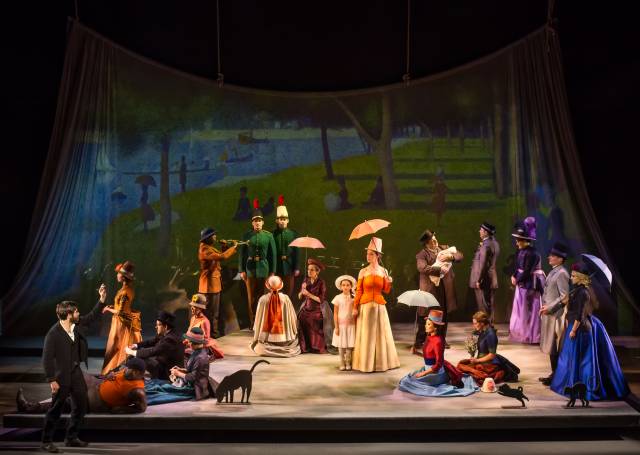

Is artistic creation more important than a romantic relationship? Are children or art the only things of value a human being can leave behind when they cease to exist? Is creativity hereditary? The questions at the center of Stephen Sondheim and James Lapine’s Sunday in the Park with George will remain relevant for as long as human beings create art, their many possible answers encompassing the dilemma of whether to wallow in self doubt or move on. Inarguably one of the greatest musicals of all time, it doesn’t take very long into Sarna Lapine’s revival to realize why this show needed to be back on Broadway: it’s become an allegory about the existence of musical theatre itself in an era of moral decay and ugliness prevailing over beauty.
The show’s hero is George Seurat (Jake Gyllenhaal) a painter who dispenses absent mindedness, arrogance, and the charm of genius in equal measures. He drives his mother (Penny Fuller) crazy, makes Parisian women swoon with his strange behavior, and continuously baffles his model Dot (Annaleigh Ashford), who despite her best attempts has fallen madly in love with him. But George only has eyes for his canvas, brushes and the visions in his mind which crave for nothing but to escape their confinement and manifest themselves in the world of the seeing. George tries to explain to Dot why it’s perhaps more important that he’s taking the time to paint her, than his lack of romantic words and elaborate dates, but she remains at a loss, wondering how she could improve, how she could make him see she’s more than the real life representation of the woman on his canvas.
As George continues to paint throughout the first act, we learn that a century hardly makes a difference as we meet Dot’s great-grandson also named George in the second act. Accompanied by his grandmother (they’re played by Gyllenhaal and Ashford respectively) the young man attends the opening of his new show: a light installation called “Chromolume #7” and inspired by Seurat, who according to family legend also happened to be his great-grandfather. But this is no genealogy mystery and the family rumors are unimportant to the show’s notion that Seurat’s pointillism was less about technique than about trying to decipher how he too could be more connected with the other “dots” around him.
What the show proposes is that whether the second George is a Seurat or not, merely by being alive he’s connected to the famous painter. Sondheim’s holistic view is a tribute to the art that inspired him, and to his own discovery that merely by “finishing a hat” he’s become a godlike figure. Perhaps it’s no coincidence that the revival’s director happens to be the niece of the book writer, and frequent Sondheim collaborator, not for the seemingly obvious idea that the show is a family property, but more because it’s George/George once more. That their relationship with the show is much more intimate than that of a regular audience member doesn’t take away from the fact that this Sunday now belongs to everyone, the musical, like the painting that inspired it, having become just another dot in the pointillistic wonder that is creation.